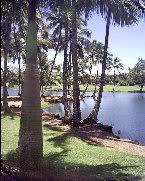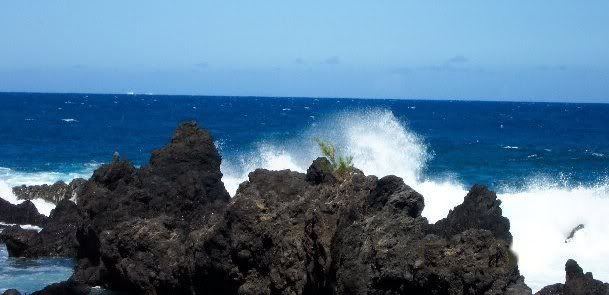

Name~ Hokule'a Kealoha
Short Bio~Hokule'a Kealoha is the Nom De Plume of a writer that formerly lived in Hawaii and is now living a life of adventure on the highways and byways of the American South . I am a Born Again follower of Jesus, as well as a wife, mother of cats and dogs,jeweler, entreprenuer, photographer and pilgrim...
Age~ Old enough to know better
Status~ Newly Single after 13 years of marriage,fur mom to the loving and devoted mini ShihTzu doggie Annabelle, born 6-11-2007 RIP 2-25-09, and the beautiful Abigail born 2-14-09
Hair Color~ natural brown/grey
Mood~ I ALWAYS have a mood, try me...
Loving~ Jesus, Hawaii, my furry friend, Abigail, my Pen Pals, Jewelry ,Blogging ,Writing anything,my Ipod,and being outdoors surrounded by my wonderful natural surroundings
Hating~ Boom Box Cars, Earspray, Abuse of Power,
Reading~
Bible
Magnificat
Link
Link
Underwired! Louisville's magazine for Women
In Store~The Magazine for the American Jeweler
Books in Progress...
CATECHISM OF THE CATHOLIC CHURCH
"Link"
"Link"
Just Finished Reading
"Link"
Link
Link
Link
Jesus, Divine Mercy ~

I Trust In You~
My Favorite Past Posts~Relive The Journey!~
2009~
Link
Link
Link
Link
Link
Link
Link
Link
2008~
Be Thankful
Colateral Damage
Make Lemonade
Home Is Where The Heart Is
The Poor With Us
Because Its The Hardest Thing I Can Do
We Have All Become Victims
Lest I Forget
The Most Important Words
Family Values
Familiar Places
May Perpetual Light Shine On Them
A City In Motion
2007~
The Quiet Storm
Fellowship of the Cane
Like Dead Unremembered: A 9-11 Tribute
The Medicine Machine
One Giant Leap
In The Steps of St. Francis
Too Much Information
The Un Choice
2006~
The Holly and the Ivy
The First 9-11, Dec 7,1941
Small Moments of Silence
Peaches to Winnipeg
Dreaming of Hawaii
Memorial Day
Scattered Values
The White Line is the Lifeline for the Nation
Warnings of a New Civil War
I Will Be True To The Promise I Have Made
The Snowy Bloody Day
Cats in the Cradle
2005~
The Journey
Rebirth of a City
For Posterity's Sake
The New Civil War
Every Mother's Son
And There You Stayed, Temporarily Lost at Sea
The Lone Rider
The Bible Is Not the Fourth Member of the Trinity
Rome Wasn't Built With Union Labor
Happy Birthday Mom ~revised~
A Beautiful Noise
Even Now
The Wearing of the Red
Night Ranger
The Joyful Traveler
Hoiliili "To Gather Up"
Ke Makakilo (My Observations)
He Giveth Sleep
Save The Children
2004~
Lux Aeterna
December 2004
You're Joking, Right?
Ground Zero
I Am Not A Failure
O,To Grace, How Great A Debtor
Lost In Translation
One Small Step for Man
The Rainbow's End
Profanity
Taps
The Journey
Makoa's Song
No Aloha For The Weakest
The Paradoxical Comandments
The Time Is Now
2003~
When No Fruit Is On The Vine


St. Edith Stein~Pray for Us
Religion Link List~
My Secret is Mine
Ignatius Insight-Online Magazine
Fr John Corapi SOLT
Dr. Scott Hahn St Paul Center
Fr. Mitch Pacwa~ Ignatius Productions
Link
Link
Link
Link
Link
Political Link List~
Link
Link
Link
link
Arkansas Link List~
Little Portion Hermitage
John Michael Talbot website
John Michael Talbot Myspace page
1st United Methodist Church Bella Vista
Northwest Arkansas Guide
Mimi's Cafe
Metro Woman Business Directory of NW Arkansas
River Grille
Link
Link
Link
Interactive Links~
Live WebCam Feed from the Mauna Lani Resort, Kohalla, Big Island of Hawaii
Click here for Aloha Joe!Live Hawaiian Music 24/7

St. Damien of Molokai'i, Patron of Hawaii and the Outcasts among us, pray for us....

Hawaii Links~ ~
For more Hawaii links Click Here
Volcano Updates (Pele's Mood Meter)Hawaii Volcano Observatory
Hawaii Volcanoes National Park
Volcano Watch Archives
Mauna Kea Observatory
Pacific Tsunami Museum
Link
Link
Link
Link
Technorotica for Blogging~




Who Links Here...Click here to see who's linking to this site. Powered by WhoLinksToMe.com
Globe of Blogs~Blog search engine
The Blog Search Engine
stock xchng
Photobucket
BlogSkins
Link
Wikipedia
Nuzio's Place on the Web
Commutefaster.com
PING ME!
MWBS Wordpress Edition
Link
Technorotica for Jewelers, and the Jewelry Trade~
Gemological Institute of America
The Drouhard National Jewelers School
The Conner School
Link
Link
|
February 27, 2005
Volcano Watch Feb 17 2005
 Flow Fly Over- Tour Helecopter flying over the lava fields of Hawaii Volcanoes National Park. HVO Photo This peice has been on the back burner for a bit. I think its important to keep in mind that Hawaii is not Disneyland and that we have some unique issues here such as the VOG. We have natually occuring acid rain and acid fog like you who live in the north east, but there is little to be done about it. I suffer terribly when the trades are not blowing and keeping Hilos air clear... a bit scary as we continue to consider places to settle... Aloha e Na Makani `Olu`Olu; (we welcome the return of the tradewinds) Residents of east Hawai`i are finally getting some relief from nearly two months of intermittently poor air quality caused by sulfur dioxide (SO2) gas and acidic particles released from Kilauea- and the southerly winds that kept these emissions in east Hawai`i. The spate of kona winds that brought the vog "home for the holidays" in December abated early last week. Undoubtedly, residents of the Hilo and Puna districts and parts of Ka`u on the Big Island had lighter hearts due to the clean air, just in time for Valentine's Day.
Those of us who work at the observatory were relieved, too, partly because we could all breathe a bit easier, since fume from Halemaumau and Pu`u `O`o was no longer blowing into the observatory or our homes. HVO's scientists were also glad to be able to measure sulfur dioxide (SO2) gas emissions from the vents again. This is a task that is important for monitoring the eruption but is difficult or impossible when trade winds are absent.
We measure these emissions by driving underneath Kilauea's volcanic plumes with a vertically directed spectrometer strapped to the side of a field vehicle. When trade winds blow, plumes from the summit and rift emission sources are opportunely blown across Crater Rim Drive and Chain of Craters Road, respectively, where they are easily quantified. When sluggish southerly or multi-directional winds take the place of the trades, the summit and rift emissions form a smeared plume that can not be accurately measured, but which often creates a pollution problem for nearby areas.
During December and January, we heard numerous complaints from residents and visitors who reported such symptoms as headache, itchy eyes, and breathing discomfort. During this period, due to the lack of trades, we could not measure the SO2 emission rate. This measure describes the amount of gas released over time and is often expressed in tonnes of SO2 emitted per day. However, other types of instruments did record high concentrations of this noxious gas, commonly reported in parts per million (ppm). As an example, the "recipe" for 10 ppm SO2 is 10 parts of SO2 mixed with 999,990 parts of air.
To further understand the difference between emission rate and concentration, we can look back to a time when bars in Hawai`i were full of smokers. We can consider the emission rate of the bar to be the amount of smoke produced in the bar over a business day. The concentration is the amount of smoke in the room at a particular time that bar patrons will experience during their visit.
Similarly, high concentrations of irritating SO2 gas are experienced at, and near, Kilauea when slow southerly winds blow the stagnant fume into populated areas. This can, and does, affect our respiratory comfort, but the true gauge of production from the volcano is expressed by the emission rate. At the summit of Kilauea, about 100 tonnes of SO2 are emitted per day. Much more SO2 comes from the Pu`u `O`o vent, which has averaged about 1,500 tonnes per day for the past several years. This emission rate increases commensurately with activity of the volcano.
The return of the trade winds last week was welcomed by those who live and work in east Hawai'i. On February 7, the first day we were able to measure SO2 emission rates again, we found that they had nearly doubled since our last measurements in December. During the next three days, they climbed to over 3,000 tonnes per day, a level we haven't seen since 2002.
This period of high SO2 emission rate corresponded to an increase in activity at the eruption site. The spatter from several cones within Pu`u `O`o crater increased, and the East Pond Vent produced a small lava flow for the first time in more than 6 months. Activity at vents outside the crater increased, as well. Dome fountains were photographed by a time-lapse camera located on the south flank of Pu`u `O`o, and the vigor of spattering from one of these vents was sufficient to destroy a seismic monitoring station located nearby.
In keeping with the ups and downs of living and working on an active volcano, we regret the loss of the monitoring equipment. However, we celebrate the return of the trade winds as we breathe more easily and measure Kilauea's gas emission rates.
Activity update
Eruptive activity at Pu`u `O`o continues. At least five of the vents inside Pu`u `O`o crater have been spattering frequently since February 1, producing bright glow from the crater on clear nights. On the night of February 10, spattering activity inside the crater escalated, and one vent, on the eastern end of the crater, produced a small fan of pahoehoe on the crater floor. The same night, the MLK vent, at the southwest base of the cone, erupted a flow that extended 500 m from the vent. The heightened activity diminished by the morning of February 11.
The PKK flow continues to host substantial breakouts from the 2,300-ft elevation to the coastal plain. Lava is entering the ocean at both West Highcastle and at Ka`ili`ili. The closest activity to the end of Chain of Craters Road, in Hawai`i Volcanoes National Park, is at West Highcastle, 2.6 km (1.6 mi) from the ranger shed. Expect a 1-to-1.5-hour walk each way and remember to bring lots of water. Stay well back from the sea cliff, regardless of whether there is an active ocean entry or not. Heed the National Park warning signs.
During the week ending February 17, four earthquakes were felt on Hawai`i Island. The first earthquake, at 3:28 a.m. on February 10, was a magnitude-3.1 located at a depth of 30 km (19 miles) about 9 km (5 miles) north of Honaunau that was felt in Captain Cook. A pair of earthquakes occurred 68 seconds apart just before 5 p.m. on Valentine's Day, February 14. They had magnitudes of 2.4 and 3.1, and occurred at depths of a little more than 1 km (0.6 miles), and were located between Kilauea summit and Volcano. A magnitude-3.0 earthquake occurred at 8:05 a.m. on February 17 and was located at a depth of only a few hundred meters (feet) in the same area as the previous pair. These three earthquakes were felt within the National Park housing and Volcano.
These felt Kilauea earthquakes are part of a swarm beneath Kilauea summit that started in mid-January. The swarm accompanies accelerated inflation of Kilauea summit, increasing from 8 cm/yr (3 inches/yr) to over 40 cm/yr (15 inches/yr).
Mauna Loa is not erupting. The summit region continues to inflate. Since July 2004, the rate of inflation and number of deep earthquakes has increased. Mauna Loa caldera is widening at an average rate of 6 cm/yr (2 inches/yr) while the flanks are widening at a faster rate of 20 cm/yr (8 inches/yr). Weekly earthquake counts have varied from 5 to over 150 in the last half of 2004 but have been less than 10 since the beginning of 2005. During the week ending February 16, six earthquakes were recorded beneath the summit area. Nearly all are 30 km (18 mi) or more deep, and most are the long-period type, with magnitudes less than 3.
Visit our web site (hvo.wr.usgs.gov) for daily volcano updates and nearly real-time Hawai`i earthquake information.
|
|
